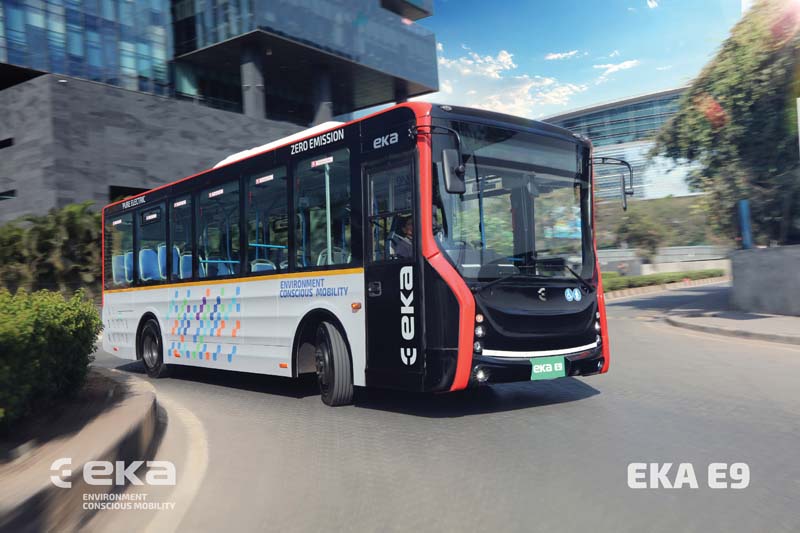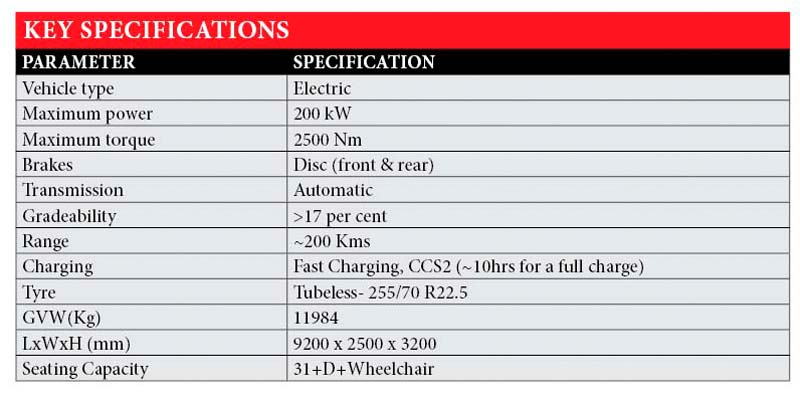EKA launched the EKA E9, its first battery-electric bus. Prateek Pardeshi draws attention to the bundled offering of design and technology.

EKA, the commercial Electric Vehicle (EV) company and a subsidiary of Pinnacle Industries, has launched its first battery-operated electric bus. Christened as EKA E9, the bus shows EKA’s commitment to providing a solid platform for sustainable and efficient public transport in cities around the world, along with reliable and profitable operations for customers. Talking about the bus, Dr Sudhir Mehta, Chairman, EKA & Pinnacle Industries Limited, mentioned, “Electrification of commercial vehicles, public transport, especially the bus sector, is key to India’s decarbonisation strategy. Today, we are excited to launch our first electric bus EKA E9, to empower cities to achieve their zero-emissions targets.” He stated that EKA’s buses are designed and optimised to provide the best ride experience, cleaner environment, and best returns to the customers. “With the new EKA E9, we offer a global platform for clean, efficient, and profitable public transport to meet the rising demand on important markets that are ready for the shift to e-mobility,” he claimed.
Launched at the recently concluded ‘The Pune Alternate Fuel Conclave (AFC)’, the nine-metre long electric bus is built on a modular concept where its drivetrain can be used on various lengths of buses from seven-metre to 10m bus variants. EKA mobility is a Joint-Venture (JV) between Pinnacle Industries and VDL Coaches and bus where Pinnacle holds a majority~ 74 per cent stake and VDL owns the remaining 26 per cent. For EKA E9, software and structure is built by Pinnacle and safety features are brought in by VDL informed Arhinat Mehta, Director, Pinnacle Industries Ltd. “Pinnacle brings in all the tech, the vehicle is built in India, the structure, the chassis and more importantly, the software is completely made in India,” commented Mehta. As customers are moving to electric vehicles, EKA’s E9 pure electric bus provides a uniquely designed, optimised, indigenous product ‘Made in India’ with innovative monocoque stainless steel chassis that ensures best-in-class corrosion-free life, low noise, and vibrations, refined composite bus body design and with an emphasis on safety, profitability, efficacy, reliability and performance.
The first impression
Looking attractive, modern and futuristic with a seemingly smiling front fascia, the E9 certainly leaves behind some of the conventionally designed buses on first glance. Creating a pull with its compact design slated for inter-city travel, the bus can be had in length of 9.2m, a width of 2.5m and a height of 3.2m. The overall weight of the vehicle is 12-tonne courtesy a lightweight stainless steel, monocoque chassis. The bus boasts of high structural strength and durability with claims of composite body panels being rust-free unlike traditional buses. A red line running from the front runs along the side and gels well with the black colour used as the permutation and combination to attract commuters. The front headlight setup has two conventional halogen bulbs with high beam and low beam, indicators placed over them and fog lights are intelligently placed as low as possible to light up the road at night. A huge panoramic type windshield offers a clear vision to the driver, A-pillars are smaller which eliminates blind spots. On all four corners of the roof, two glow lights are installed for higher safety at night.
Move on to the side of the E9, the first thing which caught our attention was the wave-like body panel pattern said to enhance the aerodynamics of the bus. It sure does give it an aesthetic look. More than 50 per cent of the overall height is covered by huge glasses, which will be beneficial for passengers allowing more light into the cabin lending it an open layout. The charging point provided on the right-hand side of the bus enables the bus driver to get a clear vision of whether the charging socket is plugged in or out. LED indicators placed on the sides and reflectors are mounted alongside the bus. The EKA badge is flaunted by the bus on the front door and on the top right-hand side. An air-con unit has been mounted above the roof sourced from Trans ACNR. The tyres on front and rear are 255/70 R22.5 radials. After a nine-metre walk, the rear reveals a straight forward design. Keeping it simple, brake lights are conventional halogen bulbs with LED flash screen mounted on the rear and front of the windshield.
Though denied access to interiors of the prototype, the seating capacity of 32 courtesy large windows revealed the driver cabin and the passenger seating area that holds a wheelchair for the specially-abled. The interiors resemble the low floor tarmac coach interiors. On the driver side, the dash is ergonomically designed with all controls placed well within the driver’s reach. A two-spoke steering wheel, with a camera screen, mounted on the right, a public address system, CCTV for passenger safety are some of the other key inclusions adding to the bus’s appeal. The camera also doubles up and can detect the number of passengers travelling on the bus. The auto-drive feature, power-assisted tilt and telescopic steering and all in one central console, provides a modern appeal. The low ingress and digress with kneeling features have the lowest 650 mm floor height, said to make it extremely comfortable and accessible to the elderly, children, women and specially-abled passengers.
The mechanics
Featuring a new streamlined vehicle design, the EKA E9 generates maximised power and range due to its monocoque stainless steel chassis and complete composite structure. It offers the lowest kerb weight and unmatched TCO in its category. Powered by an electric motor, it is said to generate a maximum power of 200 kW and torque of 2500 Nm. The bus offers faster acceleration, more horsepower, greater traction power, industry-leading reliability, along with 17 per cent grade ability to tackle any terrain with a regenerative braking system to address range anxiety on the go. With an advanced chemistry powerful Li-Ion battery suitable for city operation, the battery system is safe, durable, and efficient. EKA E9 is also equipped with a vehicle control unit software designed in-house, with an integrated strategy for vehicle features.
EKA E9’s best-in-class safety features include Front and Rear Disc Brakes with EBS, Combined Charging System (CCS2) protocol fast charger, four-cameras, emergency stop button, fire extinguisher, Automatic Driver assistance system (ADAS). Designed with the lowest centre of gravity, EKA E9 is claimed to offer stability at high speeds and turns and is easy to drive in crowded and congested city traffic.
The differentiators
The E9 has a 200 Km range on a single charge. When it exhausts complete charge, the Multi-Information Display (MID) shows a low battery warning. The bus has a reserve battery with up to 15 per cent charge which gives a range of 20-25 kilometres in case of the bus entering limp mode. The customers can also avail the option of low travel range bus where the initial cost of the vehicle comes down drastically, explained Mehta. EKA essentially removes one battery out of two and configures the setup as per customer requirements.
The body panels are completely made out of composite material, which is bolted onto the mainframe of the bus, the design of the bus can be customised as per the customers’ needs. The company has also claimed a lower carbon footprint as the painting process is completely skipped and all panels are coloured by using the die method as per the customer’s choice. The company claims all composite components used on the bus provide similar strength of safety of passengers as it has undergone tests at ARAI. A major highlight of the E9 is that most of the other OEMs have been designing the EV drivetrain in a conventional way, where the Center of Gravity (CG) is higher but at EKA, components below the floor make it a low CG bus.
Infrastructure support
EKA has signed an Memorandum of Understanding (MOU), with Bengaluru-headquartered advanced battery technology startup Log9 Materials. The partnership will focus on providing Log9 fast-charging advanced battery solution RapidX for EKA’s new energy vehicles, including their recently launched pure electric bus range, EKA E9 and soon to be launched range of Light Commercial Vehicles (LCVs). The Log9 RapidX batteries are based on the InstaCharge battery technology which enables charging time of less than 30 minutes on both the LCV and e-bus platforms of EKA. As a part of the collaboration, EKA and Log9 will be targeting to deploy at least 10,000 InstaCharged LCVs and 200+ e-buses within a year. The vehicles will be deployed initially in Mumbai and Pune Metropolitan regions, and later rolled out across other metros and geographies.
What’s next
EKA mobility has more than six patents out of which some are already granted, especially the software used which is also the USP of this bus. As per the product development team that gave us a tour of the bus, the company is looking forward to building new partnerships and signing MoUs to expand its business. Few companies are planning to use this bus for staff movement or as a shuttle service. The commercial vehicle manufacturer is in talks with various State Transport Undertakings (STUs) as public transport happens to be a major target group. The vehicle has covered a distance of more than 10,000 Kms during the testing phase. All other aesthetic components used in the bus are out sourced with the design done by EKA. As far as exports are concerned, EKA eyes expansion of their technology in many other countries with South Africa being one of the key markets Additionally, the manufacturer is one of the only manufacturers approved under the Champion OEM PLI scheme and EV component manufacturing scheme of the Government of India. With a Rs.2000 crore investment, and a benefit of 15 per cent subsidy from the government on products made by EKA, the company is already planning a LCV truck to cater to the last-mile in this financial year. “We are very fortunate, we are recognised as the champion OEM, it gives us a very strong opportunity to grow. We are a 100 per cent made-in-India product and we just don’t want to make it for India but for the global. In fact, our tag line is ‘Bharat ki EKA’ – Dr Mehta concluded.
Also read, e-Bus challenges





















